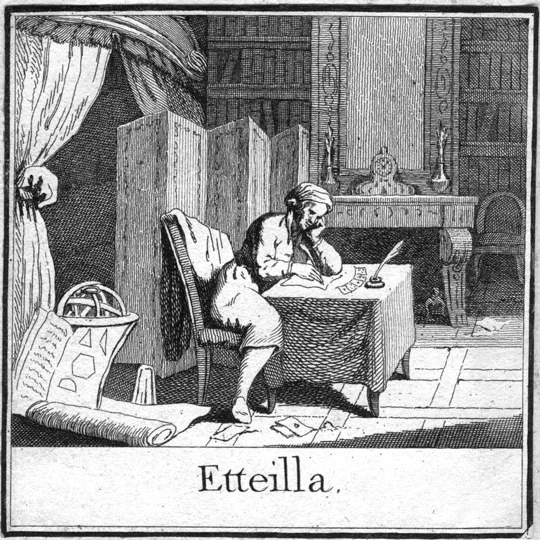Etteilla
Etteilla, the pseudonym of Jean-Baptiste Alliette (1 March 1738 – 12 December 1791), was the French occultist and tarot-researcher, who was the first to develop an interpretation concept for the tarot cards and made a significant contribution to the esoteric development of the tarot cards to a wide audience (from 1783), and therefore the first professional tarot occultist known to history who made his living by card divination.
Etteilla also influenced the French divination professional Marie Anne Lenormand. In the years 1783-1785 Etteilla published his work Manière de se récréer avec le jeu de cartes nommées tarots, which is still considered the standard reference work of Tarot cartomancy. Etteilla published his ideas of the correspondences between the tarot, astrology, and the four classical elements and four humors, and in 1789 he published his own tarot deck, which differed significantly from the classic tarots in terms of structure and card designations.
Personal life
Aside from the birth certificate recording his birth in Paris in 1738, very little is known about Jean-Baptiste Alliette's youth. His father was a maître rôtisseur, a caterer, and his mother was a seed merchant.
He married Jeanne Vattier in 1763, a marriage that lasted half a decade, during which he worked as a seed merchant, before publishing his first book in 1770. "Etteilla" is simply the reverse of his surname.
Work
His first book, Etteilla, ou maniere de se récréer avec un jeu de cartes (1770) was a discourse on the usage of regular playing cards (the piquet deck, a shortened deck of 32 cards used in gaming, with the addition of an "Etteilla" card). Features included the "spread", or disposition on the table, and strictly assigned meanings to each card both in regular and in reversed positions, characteristics that are still central to tarot divination today. In his preface, "Etteilla" explained that he had learned his system from an Italian; it remains unclear to what extent his assigned symbology was his own contribution. The book was reprinted the following year. He was working as a printseller, but from this time, approximately, he earned his livelihood by working as a consultant, teacher and author.
In 1781 the French Swiss Protestant clergyman and occultist Antoine Court de Gébelin published in his massive work Le Monde primitif his idea that the Tarot was actually an ancient Egyptian book of arcane wisdom; his work included an essay by the Comte de Mellet who first called tarot cards the Book of Thoth and, crucially, claimed that the Egyptians used the cards for fortune-telling and described what purported to be their method of divination.
There is no evidence to support the notion that tarot has an Egyptian lineage but, influenced by de Gébelin, Etteilla responded with another book, Manière de se récréer avec le jeu de cartes nommées tarots ("Way to recreate yourself with the deck of cards called tarots") in 1783. It was the first book of methods of divination by Tarot. In the book, Etteilla claimed that he had been introduced to the art of cartomancy in 1751, long before the appearance of Court de Gebelin's work, although there is no evidence to support his claim.
In 1788 he formed Société des Interprètes du Livre de Thot, a group of French-speaking correspondents through which he continued to discuss his ideas about tarot interpretation. The next year he published a special deck for divination that syncretized his ideas with older forms of French cartomancy. This was the first deck of cards specifically designed for occult purposes.
In 1790, Etteilla founded the Nouvelle Ecole de Magie (New School of Magic). Later that year, he published Cours théorique et pratique du Livre du Thot (Theoretical and practical course from the Book of Thoth), which includes his reworkings of what would later be called the Major Arcana and Minor Arcana, as well as the introduction of the four elements and astrology.
Divination decks
Etteilla is responsible for creating the first deck of tarot cards with the express purpose of being used for cartomancy. This deck was engraved by Pierre-François Basan, then hand-colored and published in 1788. The deck was a complete departure from the traditional style of the widely-available Tarot de Marseille.
Three versions of the deck were subsequently published:
- Grand Etteilla 1 by Pierre Mongie L'Aine in 1826.
- Grand Etteilla 2 by Simon Blocquel in 1838.
- Grand Etteilla 3 by De La Rue in 1867.
Books
- Mysterious Zodiac, the Oracles of Etteilla, 1772
- Etteilla, Instructions on the Art of Drawing Cards, 1783
